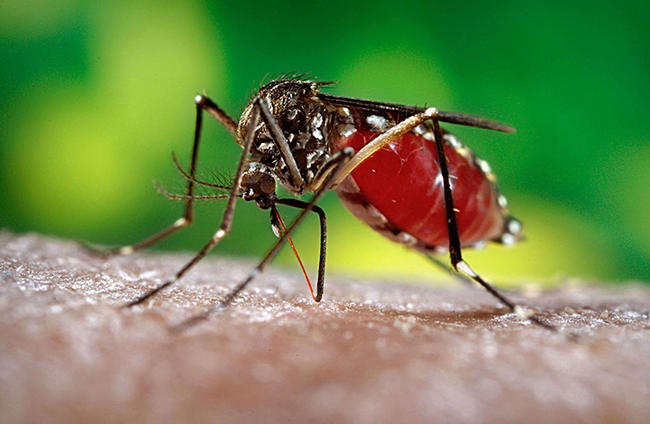- Author: Kathy Keatley Garvey

- Medical entomologist-geneticist Geoffrey Attardo, assistant professor, will receive the Medical, Urban, and Veterinary Entomology Award
- Doctoral student Erin Taylor Kelly of the Geoffrey Attardo laboratory will receive the Student Leadership Award
- Undergraduate student Gwendolyn "Gwen" Erdosh of the Louie Yang lab will receive the inaugural Dr. Stephen Garczynski Undergraduate Research Scholarship
Geoffrey Attardo is a global expert on vectorborne diseases, and renowned for his groundbreaking work on tsetse flies. Attardo, who joined the UC Davis Department of Entomology and Nematology in 2017 from the Yale School of Public Health's Department of Epidemiology of Microbial Diseases, “excels not only as a researcher, but as a teacher, mentor, scientific illustrator, macro photographer,videographer and science communicator,” said UC Davis distinguished professor Bruce Hammock in his letter of nomination. (See news story)
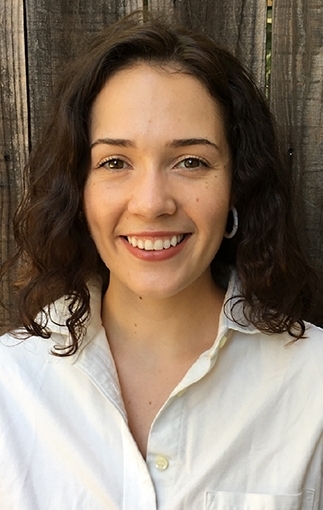
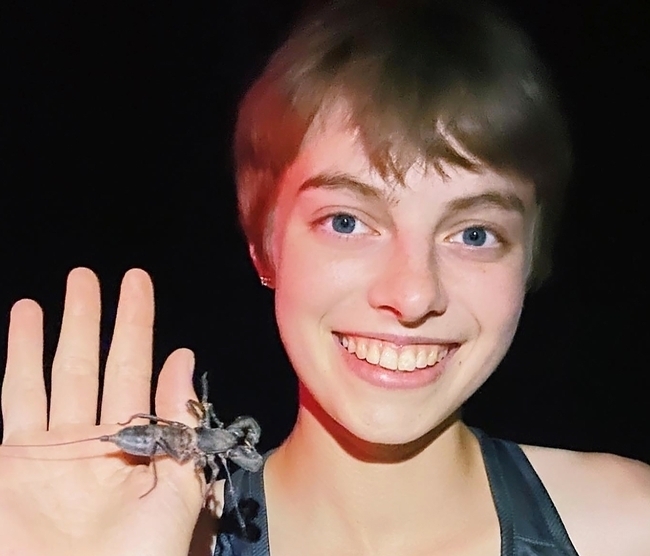
Entomology Games. The UC Davis Entomology Games team will be competing for regional honors and national representation. The team includes doctoral candidate Zachary Griebenow of the Phil Ward lab, captain; doctoral candidate Jill Oberski of the Ward lab; doctoral student Erin “Taylor” Kelly of the Geoffrey Attardo lab; and doctoral student Madison “Madi” Hendrick of the Ian Grettenberger.
The Entomology Games is a lively question-and-answer, college bowl-style competition on entomological facts played between university-sponsored student teams. It was formerly known as the Linnaean Games. The preliminary round is from 5 to 6 p.m., April 10. Plans are to hold three rounds with questions from each of the 10 categories: Biological Control, Behavior and Ecology, Economic and Applied Entomology, Medical-Urban-Veterinary Entomology, Morphology and Physiology, Biochemistry and Toxicology, Systematics and Evolution, Integrated Pest Management and Plant-Insect Interactions, History of Entomology, and Entomology in Popular Culture. (See UC Davis news story)
The final round is from 8 to 10 p.m., April 11. Both the championship team and the runner-up team will represent PBESA at the Entomological Society of America (ESA) meeting, Nov. 13-16 in Vancouver, British Columbia. Last year's national champion was the University of Hawaii, which edged Texas A&M University.
UC Davis has scored three national championships since 2015. In 2018, the University of California team won the national championship, defeating Texas A&M. The team included captain Ralph Washington Jr., then a UC Berkeley graduate student with a bachelor's degree in entomology from UC Davis; doctoral students Brendon Boudinot, Jill Oberski and Zachary Griebenow of the Phil Ward lab, and doctoral student Emily Bick of the Christian Nansen lab.
UC Davis won the national competition in both 2016 and 2015, defeating the University of Georgia in 2016, and the University of Florida in 2015.
A number of other UC Davis faculty and students will participate in the PBESA meeting. (See schedule.)
PBESA encompasses 11 Western states, parts of Canada and Mexico and several U.S. territories.
- In the United States: Alaska, Arizona, California, Hawai'i, Idaho, Montana, Nevada, Oregon, Utah, Washington, Wyoming
- U.S. Territories: American Samoa, the Federated States of Micronesia, Guam, Johnston Atoll, Commonwealth of the Northern Mariana Islands, Midway Islands, Wake Island
- In Canada: Alberta, British Columbia, Northwest Territories, Saskatchewan, Yukon
- In Mexico: Baja California, Baja California Sur, Sinaloa, Sonora
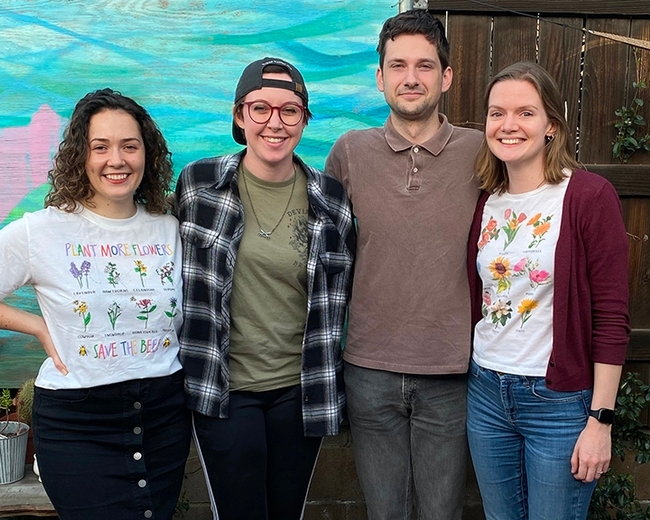
- Author: Kathy Keatley Garvey
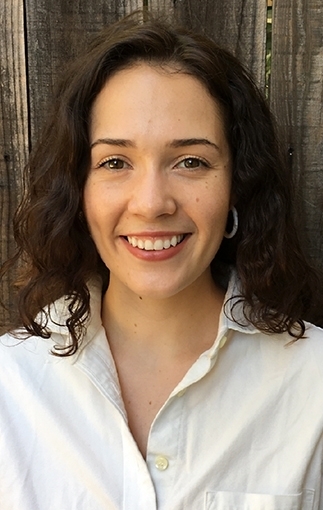
The award-winning trio:
- Medical entomologist-geneticist Geoffrey Attardo received the Medical, Urban, and Veterinary Entomology Award. (See news story)
- Doctoral student Erin Taylor Kelly of the Attardo lab won the Student Leadership Award (See news story)
- Undergraduate entomology student Gwen Erdosh of the Louie Yang lab and a member of the Research Scholars Program in Insect Biology, won the inaugural Dr. Stephen Garczynski Undergraduate Research Scholarship (See news story)
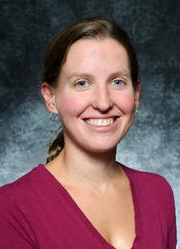
Rankin says her research "focuses on investigating species interactions and their effects on trophic dynamics and ecosystem services within the contexts of invasion biology, community ecology and evolutionary ecology." She received her bachelor's degree in biology in 2002 from Georgetown University, Washington, DC, and obtained her doctorate in biological sciences from UC San Diego in 2009. Then it was off to UC Davis for a year in the Yang lab before accepting a position as postdoctoral researcher with the University of Maryland's Department of Entomology. Rankin joined the UC Riverside faculty in 2013 as an assistant professor and advanced to associate professor in 2019.
In 2021 Rankin was named the recipient of two major awards: the Outstanding Faculty Mentor and the Academic Senate Distinguished Teaching Award. See her research and publications on her website.
Rankin's award was one of five awarded to UC Riverside entomologists:
- Mark Hoddle won the C. W. Woodworth Award
- Jessica Purcell, Distinction in Student Mentoring Award
- Dong-Hwan Choe, Distinguished Achievement in Extension Award
- Kerry Mauck, Plant-Insect Ecosystems Award
Results showed UC entomologists (from the two campuses) winning a total of eight awards, and USDA, four. (See the chart below) Congratulations, all!
Pacific Branch. The Pacific branch encompasses 11 Western states, parts of Canada and Mexico and several U.S. territories.
In the United States: Alaska, Arizona, California, Hawai, Idaho, Montana, Nevada, Oregon, Utah, Washington, Wyoming
U.S. Territories: American Samoa, the Federated States of Micronesia, Guam, Johnston Atoll, Commonwealth of the Northern Mariana Islands, Midway Islands, Wake Island
In Canada: Alberta, British Columbia, Northwest Territories, Saskatchewan, Yukon
In Mexico: Baja California, Baja California Sur, Sinaloa, Sonora
ESA, founded in 1889, is the world's largest organization serving the professional and scientific needs of entomologists and individuals in related disciplines. Its 7,000 members are affiliated with educational institutions, health agencies, private industry, and government. They are researchers, teachers, extension service personnel, administrators, marketing representatives, research technicians, consultants, students, pest management professionals, and hobbyists.
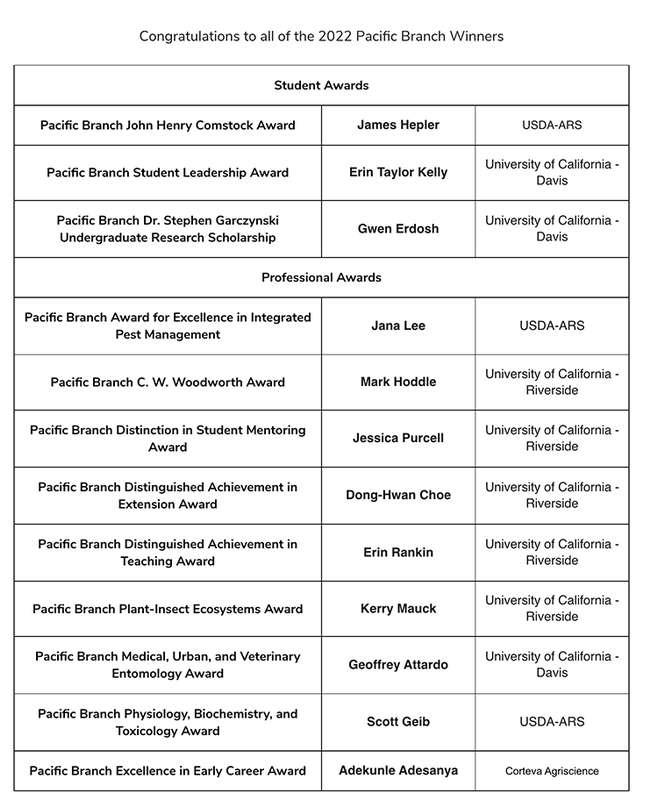
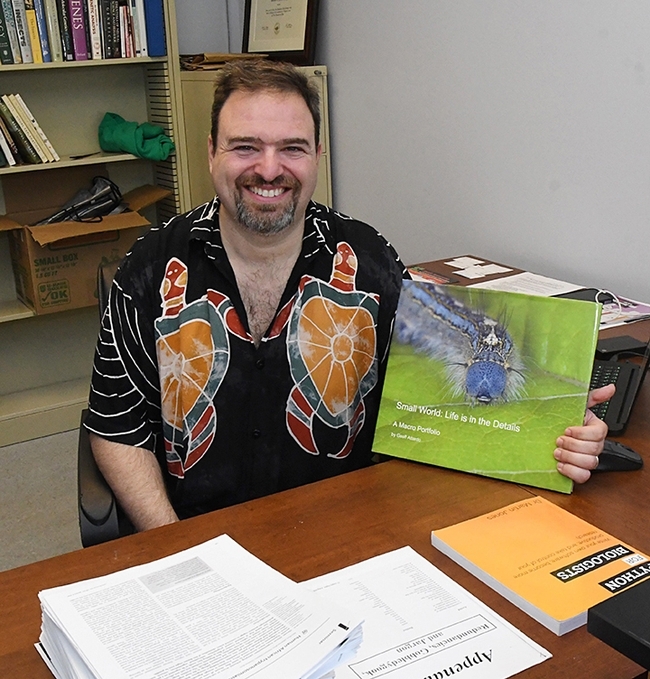
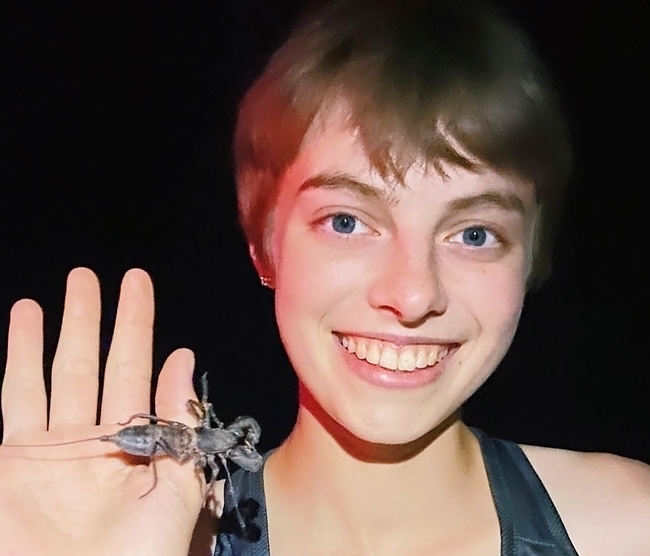
- Author: Kathy Keatley Garvey

By Geoff Attardo
Assistant Professor of Entomology and Nematology at UC Davis
California's changing climate is creating a myriad of public health concerns. Wildfires, intense heatwaves, and a drought are the most readily apparent. However, increasingly temperate winters are also facilitating the spread of invasive disease-spreading mosquitoes throughout the state. Just as our fire authorities need a robust set of tools to address wildfires, it is critical that mosquito control and public health professionals have a wide range of tools to protect Californians from mosquito-borne diseases.
The growing presence of Aedes aegypti mosquitoes, which can transmit the viruses that cause Zika, dengue, chikungunya, and yellow fever as well as the parasite that causes heartworm in pets, is a major public health threat. In 2013 this invasive species was detected in the Central Valley and has been found in California every year since. These mosquitoes cohabitate with humans and often hitchhike facilitating their spread.
Aedes aegypti lay eggs in flowerpots, water storage containers or anything capable of holding small amounts of water. Part of the problem, as highlighted in our research in Frontiers in Tropical Diseases, is that these mosquitoes have cryptic breeding sites in residential areas where mosquito control agencies can't easily inspect and treat.
In addition, their eggs can dry out and then hatch when rehydrated. In fact, when Aedes aegypti were detected in 2014 in the city of Exeter there was a large eradication effort. The effort appeared successful, as they were no longer detectable in 2015. Yet, the mosquitoes were detected in Exeter again in 2018. The unique biology of this invasive species has allowed it to expand its geographical range and today they are present in more than 300 cities in California.
Another key factor is their inherent resistance to a class of insecticides called pyrethroids, which have been a mainstay for adult mosquito control because they have low toxicity to humans and other animals. Work from our lab and the California Department of Public Health found increasing insecticide resistance in these mosquitoes (Parasites and Vectors) which limits the ability of mosquito control agencies to act against adult mosquitoes in a time of crisis.
In order to protect public health, mosquito control agencies need effective tools in their toolbox. One innovative approach takes advantage of the fact that male mosquitoes do not bite; only female mosquitoes bite and can spread viruses. This approach works by releasing sterile male Aedes aegypti mosquitoes. These male-only mosquitoes carry a self-limiting gene that prevents their female offspring from surviving. When they mate with females, this reduces the abundance of biting females in the next generation. One of the benefits of this species-specific approach is that it only targets the Aedes aegypti mosquito. This means that wildlife, such as butterflies and bees, are unharmed.
The public health threat of Aedes aegypti cannot be overstated. The World Health Organization (WHO) estimates that dengue fever causes approximately 40,000 deaths a year and Zika virus, of which there were over 5,100 symptomatic domestic cases in 2016, is known to cause serious birth defects and miscarriage as well as Guillain-Barré syndrome. The WHO also said “the potential public health benefit of practical and effective new tools to reduce or even eliminate diseases such as malaria and dengue is clear and widely recognized.”
A company called Oxitec is working with government agencies to bring its innovative mosquito control technology to the U.S. In August, they announced they are seeking regulatory approvals to expand their pilot program to bring their Friendly™ Aedes aegypti technology to California. I encourage regulators to allow the company to work with mosquito control agencies to determine the technology's effectiveness in California.
It's clear that we need efficient mosquito control tools, and we cannot wait until we have a public health emergency to act. As we have seen with the COVID pandemic it is critical to have an infrastructure in place, especially one that includes innovative – and proven – technologies, to help public health and mosquito controls stay ahead of the curve.
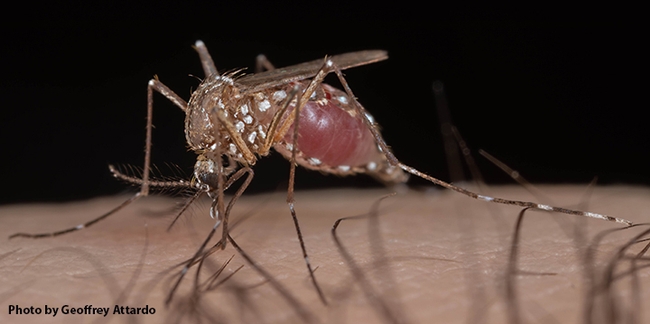
- Author: Kathy Keatley Garvey
Ah, Saturday, April 17. It's the 107th Annual UC Davis Picnic Day! What's a picnic without bugs?
This year's event, all virtual, is themed "Discovering Silver Linings," and you can do just that by watching the pre-recorded videos and by participating in the Zoom sessions. Check out the Picnic Day schedule of events which include entomological exhibits and talks from the UC Davis Department of Entomology and Nematology, Bohart Museum of Entomology and the UC Davis Graduate Student Association.
New additions to the line-up (featured on the Bohart Museum of Entomology website), involve what you could call "The good, the bad and the bugly." Blue orchard bees, tsetse flies and mosquitoes are spotlighted in UC Davis research-based videos created by KQED's Deep Look series and presented by PBS Digital Studios. Each runs about four minutes.
Here are the KQED productions:
- Watch this Bee Build Her Bee-Jeweled Nest, featuring blue orchard bees, the project of UC Davis doctoral student Clara Stuligross.
- A Tsetse Fly Births One Enormous Milk-Fed Baby, showcasing the work of medical entomologist Geoffrey Attardo, assistant professor, UC Davis Department of Entomology and Nematology.
- This Dangerous Mosquito Lays Her Armored Eggs--in Your House, involving the Aedes aegypti mosquitoes that the Attardo lab studies.
Clara Stuligross, Doctoral Student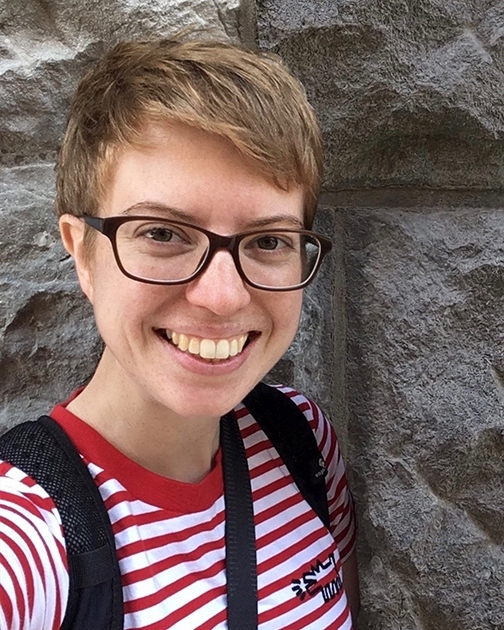
They exposed the bees to the neonicotinoid insecticide imidacloprid, widely used in agriculture, and found that the combined threats—imidacloprid exposure and the loss of flowering plants—reduced the bee's reproduction by 57 percent, resulting in fewer female offspring.
Other scientists have conducted similar research on honey bees, but this is the first comparable research on wild bees in field or semi-field conditions. The blue orchard bee, nicknamed BOB, is a dark metallic mason bee, smaller than a honey bee. It is prized for pollinating almond, apple, plum, pear, and peach trees. California almond growers often set up bee boxes or "bee condos" for blue orchard bees to aid in honey bee pollination. In the wild, the bees nest in reeds or natural holes.
Update? "We are currently working on a follow-up study to investigate potential carryover effects of past insecticide exposure on the same bee population, as well as how repeated pesticide exposure over multiple years impacts bee population growth," Stuligross said today.
Geoffrey Attardo, Medical Entomologist-Geneticist 
What many people do not know: "Female tsetse flies carry their young in an adapted uterus for the entirety of their immature development and provide their complete nutritional requirements via the synthesis and secretion of a milk like substance," Attardo says.
Attardo led landmark research published Sept. 2, 2019 in the journal Genome Biology that provides new insight into the genomics of the tsetse fly. The researchers compared and analyzed the genomes of six species of tsetse flies. Their research could lead to better insights into disease prevention and control.
The Deep Look episode on mosquitoes, "This Dangerous Mosquito Lays Her Armored Eggs-- in Your House," deals with the ability of Aedes aegypti eggs to survive out of water. Wrote the producers: "The Aedes aegypti mosquito, which can transmit dengue fever and Zika, makes a meal of us around our homes. And her eggs are hardy. They can dry out, but remain alive for months, waiting for a little water so they can hatch into squiggly larvae."
- Author: Kathy Keatley Garvey

The species has now reached at least 17 California counties and its successful spread may be linked to its resistance to pyrethroids, according to newly published UC Davis research examining genetic markers of resistance at five state locations.
The work, published in the current edition of Parasites & Vectors, a BioMed Central open-access medical journal, focuses on “determining how informative well-established genetic markers of resistance to pyrethroids are in predicting the resistance phenotype of individual mosquitoes of Aedes aegypti within a population,” said Attardo, the lead author.
“Specifically, we generated mosquito colonies from invasive A. aegypti populations from four locations in the Central Valley (Dinuba, Clovis, Sanger and Kingsburg) and from collections in the Greater Los Angeles Area,” he said. “Mosquitoes from these populations have all demonstrated resistance to pyrethroid-type insecticides and we think this may be part of the reason why these mosquitoes have been so successful in spreading throughout California.”
A. aegypti transmits such viruses as dengue, Zika, chikungunya, and yellow fever. Despite California's aggressive surveillance and treatment efforts, this species presents a “significant challenge to local control agencies,” the nine-member team wrote in their research paper, “Frequency of Sodium Channel Genotypes and Association with Pyrethrum Knockdown Time in Populations of Californian Aedes aegypti.“
The paper is online and publicly accessible at https://bit.ly/3vmUxXR.
“What was interesting was that while all the mosquitoes from California show resistance to pyrethroids, there is a lot of variability from one individual to the next in terms of the level of resistance, even when they are carrying genetically identical resistance mutations,” Attardo said. “In particular, there seem to be two levels of resistance in these populations. The two levels seem to represent a resistant group and a super resistant group. However, the proportions of resistant/super-resistant differ in the sampled mosquitoes from population to population.”
Of particular interest was that mosquitoes carrying the resistance mutations at all five genetic locations were very resistant, he said. “However, there was also a large amount of unexplained variability in terms of the knockdown phenotypes demonstrated by mosquitoes of the same age and rearing conditions. We compared the knockdown times of mosquitoes positive for all five resistance mutations from different populations and found that these mutations account for only a proportion of the observed level of resistance. We believe that the unexplained variability is likely being mediated by the presence or absence of an undefined resistance mechanism.”
Although A. aegypti was first detected in California in 2013, researchers believe that its arrival involved multiple introductions. Populations in Southern California are thought to have crossed the border from Mexico, while Central Valley populations may have been introduced, in part, from the southeastern United States.
“Upon detection in 2013, the Consolidated Mosquito Abatement District implemented an integrated vector control management strategy which involved extensive public education, thorough property inspections, sanitation, insecticide treatment at larval sources and residual barrier spraying with pyrethroids,” the authors wrote. Despite their efforts, the species successfully overwintered and continued to spread, implicating that it arrived in California with genetic mutations “conferring resistance to the type I pyrethroid insecticides applied for vector control in California.”
The co-authors include former UC Davis mosquito researcher Yoosook Lee, now at the University of Florida-Florida Medical Entomology Laboratory, Vero Beach; research entomologist Anthony Cornel and staff research associate Katherine Brisco of the Mosquito Control Research Laboratory, Kearney Agriculture and Extension Center and UC Davis Department of Entomology and Nematology; and Lindsey Mack, Erin Taylor Kelly, Katherine Brisco, Kaiyuan Victoria Shen, Aamina Zahid, and Tess van Schoor, all with the UC Davis Department of Entomology and Nematology.
For more information and photos, see news story on "UC Davis Researches Examine Pyrethroid Reistance in Spread of Aedes aegypti," on the UC Davis Department of Entomology and Nematology's website.
